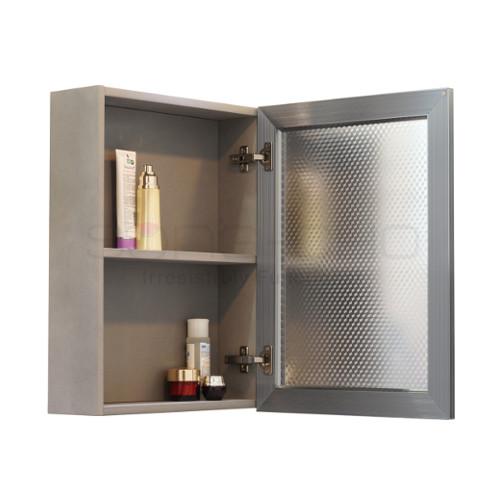In the world of interior design and functional home storage, few pieces of furniture embody elegance, practicality, and versatility like the mirror cabinet. Whether found in a sleek modern bathroom or a cozy vintage-style bedroom, the mirror cabinet stands as a quiet hero—reflecting not just your image, but your lifestyle, personality, and taste. It's more than just a surface to check your reflection; it’s a design feature that harmonizes utility with visual appeal.
So, what exactly is a mirror cabinet? Simply put, a mirror cabinet is a piece of furniture that integrates a mirror into the front of a storage unit, typically mounted on a wall. This clever dual-purpose design allows it to serve as both a mirror and a cabinet, offering a stylish solution to the age-old dilemma of space-saving without sacrificing function or beauty.
A Brief History and Evolution
Mirror cabinet have been around for decades, originally conceived as a practical storage solution in small bathrooms. Initially, they were purely utilitarian—metal boxes tucked behind a mirror where one could store toothpaste, razors, and medicine. However, as interior design trends evolved, so did the mirror cabinet. Today, they’re crafted from a wide variety of materials including wood, stainless steel, aluminum, and even glass, and come in a range of designs from ultra-modern to charmingly rustic.
Designers have embraced mirror cabinets as opportunities to add character and sophistication to a room. Now, they come with features like LED lighting, anti-fog technology, touch sensors, Bluetooth speakers, and even hidden charging ports for electric toothbrushes or shavers. The humble mirror cabinet has grown up, and it's here to make a statement.
Types of Mirror Cabinets
Mirror cabinets can be found in several forms, each catering to specific needs and styles:
- Surface-Mounted Mirror Cabinets
- These are attached directly to the wall and protrude outward. They are easy to install and typically provide more storage space. Ideal for renters or quick renovations, they are the most common type seen in homes.
- Recessed Mirror Cabinets
- Installed within the wall cavity, these cabinets sit flush against the wall for a sleek, minimalist look. While they require more effort and often professional installation, the aesthetic payoff is significant.
- Corner Mirror Cabinets
- Perfect for tight spaces or unconventional layouts, corner mirror cabinets are designed to fit snugly into a corner, making efficient use of space while still offering a mirror and hidden storage.
- Double or Triple-Door Mirror Cabinets
- Great for larger bathrooms or shared spaces, these provide extensive storage and wide reflective surfaces, often with internal mirrors as well for multi-angle viewing.
- Illuminated Mirror Cabinets
- Integrated lighting transforms these cabinets into luxurious centerpieces. They’re perfect for applying makeup, grooming, or creating a relaxing ambiance in your bathroom.
Functional Benefits of Mirror Cabinets
What makes mirror cabinets so beloved by homeowners and designers alike? It comes down to their multipurpose functionality:
- Space-Saving Design: In smaller rooms, especially bathrooms, every inch of space counts. A mirror cabinet provides both a mirror and storage in one compact unit.
- Organization: With shelves and compartments hidden behind the mirror, it’s easy to keep toiletries, cosmetics, and medications organized and out of sight.
- Visual Enhancement: Mirrors reflect light, making rooms appear larger and brighter. A mirror cabinet can visually expand your space while enhancing natural and artificial lighting.
- Aesthetic Flexibility: From minimal and modern to vintage and ornate, mirror cabinets come in styles to suit any décor.
- Enhanced Functionality: With added features like lighting, defoggers, and built-in power outlets, mirror cabinets can do much more than just hold your toothbrush.
Where to Use Mirror Cabinets
While commonly associated with bathrooms, mirror cabinets are versatile enough to be used in other areas of the home:
- Bedrooms: A mirror cabinet above a dresser or vanity can store jewelry, makeup, or accessories.
- Hallways: Use one near the entryway for a quick glance before heading out, while keeping keys and essentials tucked neatly behind the glass.
- Closets: Inside or outside a walk-in closet, a mirror cabinet offers storage for grooming tools, ties, or watches.
- Living Rooms: In modern designs, mirrored furniture can double as art and utility—offering hidden storage while reflecting and amplifying the room’s ambiance.
Choosing the Right Mirror Cabinet
When selecting a mirror cabinet, consider the following:
- Size: Match the cabinet to the dimensions of your space. Too small, and it won’t be functional; too large, and it could overwhelm the room.
- Material: Choose materials that withstand the humidity of a bathroom, or opt for wood and glass combinations for living and sleeping spaces.
- Style: Make sure the cabinet complements the room’s existing aesthetic. Sleek frameless mirrors suit modern interiors, while wooden frames add warmth and traditional charm.
- Features: Decide if you want lighting, internal mirrors, adjustable shelves, or tech integrations like Bluetooth or defoggers.
Final Reflection
The mirror cabinet is the epitome of smart design—a seemingly simple object that brings beauty, clarity, and function to your everyday routine. Whether you’re designing a new home or upgrading a single room, incorporating a mirror cabinet is a small choice with big impact. It declutters your space, enhances your style, and reflects the thoughtful details that turn a house into a home.



